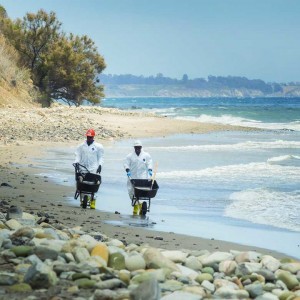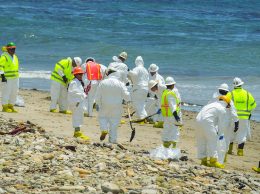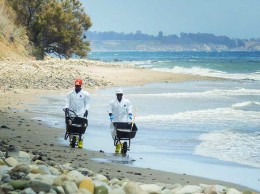Plains All American Pipeline faces class action lawsuit by property owners over Refugio oil spill
IN THIS ARTICLE
- Energy Topic
- Staff Report Author
By Staff Report Thursday, June 25th, 2015
Litigation over the May 19 Plains All American Pipeline spill off the Gaviota Coast gained a powerful combatant on June 24 when former Santa Barbara City Attorney Barry Cappello said he’d filed a class action lawsuit on behalf of 3,000 property owners from Point Conception to the Mexico border.
Capello’s lawsuit comes as tar balls that resulted from the spill were found on beaches in Ventura and Los Angeles counties. Capello, as city attorney, sued the oil companies responsible for the 1969 oil spill off Santa Barbara’s coast and he more recently sued Santa Barbara on behalf of minority residents ending the at-large voting system in favor of districts.
The lawsuit alleges that Plains’ 24-inch-wide Line 901 pipeline, a spur line that extends for 10 miles adjacent to the shoreline, lacked an automatic shut-off system that would have prevented such a large oil spill from occurring. When the pipeline was built in 1987, according to the lawsuit, Santa Barbara County demanded that a shut-off system be installed and that the county inspect the welds on the pipeline. Instead, the defendants sued, arguing that the county lacked the authority to force it to install an automatic shut-off system or inspect its pipeline.
“This was no accident,” said Cappello, managing partner of Cappello & Noël LLP, in a statement.
“This was a total disregard of safety measures on the part of Plains. Federal agencies have cited Plains for at least 175 safety and maintenance violations since 2006. It’s paid millions of dollars in fines. This is the way Plains operates. It plays fast and loose when it comes to safety and now property owners, wildlife, the environment and all those who enjoy the California coastline are paying a very high price.”
“Ocean and beachfront properties along California’s Pacific Coast are highly desirable and valuable places to live,” Cappello said in the statement. “Property owners had enjoyed unspoiled sand and water and direct access to fishing, surfing and other water sports. These waters are home to a wide variety of fish, birds and aquatic mammals. All this is now damaged by the spill and the damage and threat of additional spills will likely last decades.”
The Santa Barbara County Health Department recommends that residents avoid the areas affected by the spill, and not come in direct contact with oil or inhale the fumes, which can cause skin irritation, nausea, vomiting and other illnesses. “This can be difficult to do when you live next to the contaminated ocean,” said Lawrence Conlan, a Cappello & Noël partner working on the case.
The suit was filed in federal court for the Central District of California. The named plaintiff, a family trust, owns beachfront real property just north of Refugio State Beach along the Santa Barbara County coast. Plains has not commented on the suit but stated on June 24 that cleanup costs from the spill have reached $92 million.













